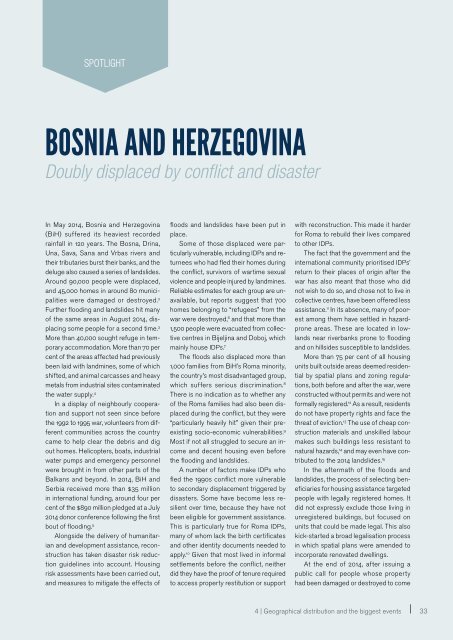Estimates
bzTPL9
bzTPL9
- No tags were found...
Create successful ePaper yourself
Turn your PDF publications into a flip-book with our unique Google optimized e-Paper software.
SPOTLIGHTBOSNIA AND HERZEGOVINADoubly displaced by conflict and disasterIn May 2014, Bosnia and Herzegovina(BiH) suffered its heaviest recordedrainfall in 120 years. The Bosna, Drina,Una, Sava, Sana and Vrbas rivers andtheir tributaries burst their banks, and thedeluge also caused a series of landslides.Around 90,000 people were displaced,and 45,000 homes in around 80 municipalitieswere damaged or destroyed. 2Further flooding and landslides hit manyof the same areas in August 2014, displacingsome people for a second time. 3More than 40,000 sought refuge in temporaryaccommodation. More than 70 percent of the areas affected had previouslybeen laid with landmines, some of whichshifted, and animal carcasses and heavymetals from industrial sites contaminatedthe water supply. 4In a display of neighbourly cooperationand support not seen since beforethe 1992 to 1995 war, volunteers from differentcommunities across the countrycame to help clear the debris and digout homes. Helicopters, boats, industrialwater pumps and emergency personnelwere brought in from other parts of theBalkans and beyond. In 2014, BiH andSerbia received more than $35 millionin international funding, around four percent of the $890 million pledged at a July2014 donor conference following the firstbout of flooding. 5Alongside the delivery of humanitarianand development assistance, reconstructionhas taken disaster risk reductionguidelines into account. Housingrisk assessments have been carried out,and measures to mitigate the effects offloods and landslides have been put inplace.Some of those displaced were particularlyvulnerable, including IDPs and returneeswho had fled their homes duringthe conflict, survivors of wartime sexualviolence and people injured by landmines.Reliable estimates for each group are unavailable,but reports suggest that 700homes belonging to “refugees” from thewar were destroyed, 6 and that more than1,500 people were evacuated from collectivecentres in Bijeljina and Doboj, whichmainly house IDPs. 7The floods also displaced more than1,000 families from BiH’s Roma minority,the country’s most disadvantaged group,which suffers serious discrimination. 8There is no indication as to whether anyof the Roma families had also been displacedduring the conflict, but they were“particularly heavily hit” given their preexistingsocio-economic vulnerabilities. 9Most if not all struggled to secure an incomeand decent housing even beforethe flooding and landslides.A number of factors make IDPs whofled the 1990s conflict more vulnerableto secondary displacement triggered bydisasters. Some have become less resilientover time, because they have notbeen eligible for government assistance.This is particularly true for Roma IDPs,many of whom lack the birth certificatesand other identity documents needed toapply. 10 Given that most lived in informalsettlements before the conflict, neitherdid they have the proof of tenure requiredto access property restitution or supportwith reconstruction. This made it harderfor Roma to rebuild their lives comparedto other IDPs.The fact that the government and theinternational community prioritised IDPs’return to their places of origin after thewar has also meant that those who didnot wish to do so, and chose not to live incollective centres, have been offered lessassistance. 11 In its absence, many of poorestamong them have settled in hazardproneareas. These are located in lowlandsnear riverbanks prone to floodingand on hillsides susceptible to landslides.More than 75 per cent of all housingunits built outside areas deemed residentialby spatial plans and zoning regulations,both before and after the war, wereconstructed without permits and were notformally registered. 12 As a result, residentsdo not have property rights and face thethreat of eviction. 13 The use of cheap constructionmaterials and unskilled labourmakes such buildings less resistant tonatural hazards, 14 and may even have contributedto the 2014 landslides. 15In the aftermath of the floods andlandslides, the process of selecting beneficiariesfor housing assistance targetedpeople with legally registered homes. Itdid not expressly exclude those living inunregistered buildings, but focused onunits that could be made legal. This alsokick-started a broad legalisation processin which spatial plans were amended toincorporate renovated dwellings.At the end of 2014, after issuing apublic call for people whose propertyhad been damaged or destroyed to come4 | Geographical distribution and the biggest events33


